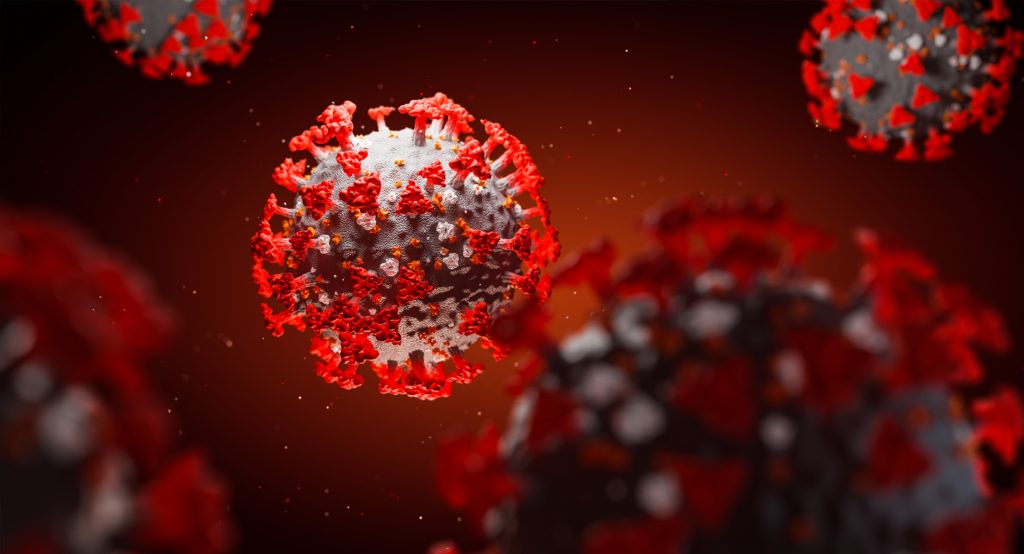
Overview
Coronaviruses are a broad family of viruses that cause upper respiratory tract infections.1 This family of viruses includes SARS-CoV, MERS-CoV and our current pandemic coronavirus, SARS-CoV-2, among others. COVID-19 is the illness that SARS-CoV-2 causes. On March 11, 2020, the WHO declared the novel coronavirus had reached the level of pandemic. WHO defines a pandemic as the worldwide spread of a new disease.2
Transmission
SARS-CoV-2 is spread from person to person. This happens through respiratory droplets that land in the eyes, nose or mouths of others. These droplets can also land on surfaces that people touch. Contaminated surfaces can spread virus to the hands and then infect an individual if they then touch their face. Respiratory droplets are naturally produced when someone talks, laughs, sneezes or coughs.3 These droplets are not always visible. Additionally, studies show that you do not need to be symptomatic to transmit the virus.3 Everyone is at risk of becoming infected with the virus and spreading it. Currently, there is no vaccine or effective treatment for COVID-19.
Symptoms
There are a wide range of COVID-19 symptoms. Illness can range from mild to severe and even become fatal.4 The CDC states that symptoms of the virus can appear after two days or after as many as 14 days post-exposure.4 The current list of common symptoms includes cough, shortness of breath or difficulty breathing, fever, chills, muscle pain, sore throat and new loss of taste or smell.3 This is not a complete list of all symptoms; there have been reports of gastrointestinal symptoms, but these present less frequently.
Prevention
Currently, there is not a SARS-CoV-2 vaccine. To prevent spread and reduce exposure to the novel coronavirus, everyone should:
- Wash your hands often with soap and clean water
- Avoid touching your face
- Use hand sanitizer with at least 60% alcohol (when hands are not visibly soiled and handwashing is not feasible)
- Avoid close contact with others outside of your household
- Wear a cloth face cover when around others
- Cover coughs and sneezes with a tissue or crook of the elbow (not your hand)
- Clean and disinfect high-touch surfaces.3
Hierarchy of Controls
The hierarchy of controls is a framework that occupational health and safety professionals use to eliminate or reduce the risk of exposure to a hazard in a workplace.5,4 The controls include (from most effective to least effective): elimination, substitution, engineering, administrative and personal protective equipment (PPE). Neither elimination nor substitution are controls that are currently available for the novel coronavirus. The elimination control eliminates the hazard from the individual. A vaccine for measles is an example of elimination since it eliminates the hazard of infection. Substitution involves switching something hazardous for something that does not contain the hazard. An example of substitution includes a hazardous paint (like lead paint) being switched in favor of a paint that does not have lead.
Engineering, administrative and PPE are available controls for SARS-CoV-2.4 Engineering controls involve removing employees from workplace hazards and do not rely on modified behavior. Examples include installing high-efficiency particulate air filters and sneeze guards. Administrative controls rely on behaviors from employers or employees and often are reflected in policy and procedure modifications that reduce exposure.4 OSHA has created an extensive list of administrative control examples. Lastly, PPE may be required to prevent some exposures. This control should not replace other prevention methods. Examples include respirators and face shields. Typically, controls are most effective at controlling hazards when used in combination.
Conclusion
Researchers are constantly discovering new insights regarding the novel coronavirus, its spread and how we can best protect ourselves and others. While there is not a vaccine or elimination control currently available, there are other measures that can be taken to reduce and mitigate exposure and transmission risks.
References
1. Coronaviruses | NIH: National Institute of Allergy and Infectious Diseases. http://www.niaid.nih.gov/diseases-conditions/coronaviruses.
2. WHO | What is a pandemic? WHO http://www.who.int/csr/disease/swineflu/frequently_asked_questions/pandemic/en/.
3. CDC. Coronavirus Disease 2019 (COVID-19) – Prevention & Treatment. Centers for Disease Control and Prevention https://www.cdc.gov/coronavirus/2019-ncov/prevent-getting-sick/prevention.html (2020).
4. Guidance on Preparing Workplaces for COVID-19. 35.
5. CDC – Hierarchy of Controls – NIOSH Workplace Safety and Health Topic. https://www.cdc.gov/niosh/topics/hierarchy/default.html (2018).